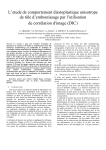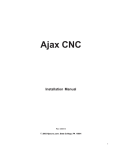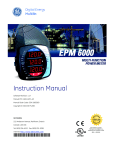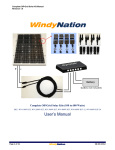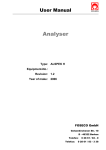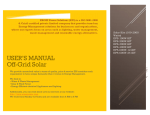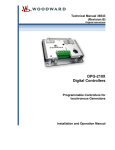Download Auto Body Construction in Top Shape
Transcript
5 3 + 4 / 2 0 11 HEIDENHAIN News from the World of HEIDENHAIN Controls The iTNC 530 in Operation Auto Body Construction in Top Shape KinematicsComp Proves Itself in Practice Greater Accuracy through Volumetric Compensation Page 8 Productivity Right from the Start “Our First iTNC!” Page 12 2 The iTNC 530 in Operation for Peugeot and Citroën The Real World Auto Body Construction in Top Shape As KLARTEXT correspondents we have already enjoyed the opportunity of gaining interesting insights into the large-scale mold and die making of German car manufacturers. What we learned: HEIDENHAIN’s control technology assists BMW, Audi and Volkswagen in the efficient and economic production of high-quality tools. One question still needed to be answered: whether other European car manufacturers have also noticed the advantages of controls from HEIDENHAIN. That’s what we wanted to find out, so we set off for France—all the way across the country from east to west. Deep-drawing tools for the production of car chassis parts have impressive properties: despite their large dimensions (up to 4.5 meters long), they have very precise geometries and particularly high-quality surfaces. In general, such a deep-drawing tool consists of three parts: the forming die and shoulder, the blank holder and the drawing punch. Together these parts can weigh up to 32 metric tons for a single tool! So it is no wonder that, due to economic considerations, only one deep-drawing tool is manufactured for any given chassis part. This tool then produces this part for the entire vehicle series. This not only places high Patrick Menier (left) and Philippe Galisson, PSA Rennes, in front of the MODUMILL demands on the tool itself, but also on the safety and reliability of the entire process for manufacturing the deep-drawing tool. This process takes several months. First, on the basis of the CAD data, a polystyrene model is used to cast the blank form. The blank form has up to 15 mm of excess material compared to the finished deepdrawing tool. There are good reasons for this: along with the tolerances that must be considered when casting such large parts, inclusions and micro-cracks can occur near the surface, and these must not extend down into the actual deep-drawing tool. So a very large amount of material must be removed. Once the blank form arrives from the foundry, it is measured optically in order to generate a CAD program for the roughing operations. Roughing is followed by finishing in two steps: semi-finishing, after which there is still approx. 1 mm of excess material, and then final fishing with a high level of accuracy. Other component parts are than added to the deep-drawing tool, which is then ready to deep-draw some sample parts on a testing machine. If the sample parts validate the tool’s geometry, then it is time to polish the tool—a very tiring and time-consuming manual process. But this production step is very important, since the sheet metal is pulled over the tool surface in deep-drawing—hundreds of thousands of times during the course of the tool’s life. Any contaminations would be detected on the manufactured part immediately, and could even lead to defective deep-drawn parts. After the polished tool has passed all inspections it is ready for operation in the production department. So it is clear why the safety and reliability of the manufacturing process is of such importance: were the deep-drawing tool to become damaged at any time, the entire process would have to start over from the beginning. This would endanger the scheduled start of an entire vehicle series, with the corresponding financial losses as well as damage to the car manufacturer’s reputation. This, in turn, places highest demands on the tools and machines with which the deep-drawing tools are produced. With machining times of up to 300 hours per deep-drawing tool, the milling step is at the focus of attention. Quality and reliability are absolutely essential, but economic considerations apply nevertheless. PSA – a visit to Europe’s second-largest car manufacturer The PSA employees in the toolbuilding departments, whose responsibilities include the manufacture of deep-drawing tools, are caught in this conflict. The PSA Group, to which Peugeot and Citroën belong, is the second-largest car manufacturer in Europe, behind only Volkswagen. PSA has two toolbuilding departments: one is in the city of Rennes, in the Brittany region of northwestern France, and the other in Sochaux, near the Swiss border. They both have the same tasks, namely supplying all PSA assembly sites with deep-drawing tools for car chassis parts. And of course this means that they have the same goals: reduction of the costs and time involved in manufacturing these tools, with a simultaneous increase in the quality, and if possible, the creation of new possibilities for producing the chassis geometries. Rennes and Sochaux work hand in hand to achieve these goals. Needed: New controls for large machine tools makers at PSA were enthusiastic after the iTNC 530 had been presented for them. This was also the case when the decision had to be made regarding the new generation of numerical controls and feedback control accessories for operating the many large milling machines used at these sites. This decision became necessary, since the controls used until then could no longer fulfill the more sophisticated demands. The functions and performance data of the controls lagged behind the capabilities of the machines and the demands placed on the tools. Considerations regarding the reliability of the controls, support by the manufacturers and the availability of spare parts were other reasons to look for a new solution. They immediately saw functions that had been lacking from other companies’ controls, and were impressed by the precision of the pattern machining cycles. The control also fulfilled other important criteria regarding performance and reliability. This was followed by a visit to the toolbuilding colleagues at the BMW factory in Munich, where the impression was reinforced that the controls from HEIDENHAIN were well-suited for large-scale mold making (see page 4 of Klartext 51). The decision in favor of HEIDENHAIN was therefore logical and correct, and has proven itself as the successful solution. Here are the details: It was obvious from the beginning that this was a strategic decision with longterm effects. One of PSA’s important economic principles is the standardization of the machinery at its plants, in order to harmonize processes and simplify operations for the machinists. So it was not simply a case of finding a new control for just a few machines, but rather a control system that could be used on all machines, whether new or retrofitted. It was also clear that both sites would follow the same road. Retrofitting – Almost as good as new Found: Reliability and power After having screened the market, the search led to HEIDENHAIN. Since HEIDENHAIN is present in over 50 countries, including a branch office in France, it was just a short way to go. The decision NSE3, an authorized HEIDENHAIN retrofitter, retrofitted the first machine in Rennes in 2008: a MODUMILL from the French machine-tool manufacturer Forest-Liné. The machine, equipped with two spindle heads for roughing and finishing, is only a few years old, but the original control was not reliable, there were problems with the workpiece quality (which could not be solved despite extensive efforts), and functions for 2-D machining were missing, so retrofitting seemed like a good idea. Regional authorized HEIDENHAIN agencies were responsible for these tasks, as with all retrofitting jobs in general. This ensured that not just the material goods, but also their installation, met the high quality demands placed by HEIDENHAIN and PSA. Convenient: Probing with the new handwheel The Real World 3 Klartext + Issue 53 + 04/2011 The Real World 4 Patrick Menier controlling the VERTAMILL 229 The result: “The MODUMILL is absolutely reliable. If we start a complicated machining sequence on Friday evening, then we can be sure that Monday morning we’ll find a smoothly running machine, and not one at standstill with an error message on its screen,” reassured us Philippe Galisson, head of Production and Production Tools in Rennes. Speaking of complicated machining sequences: programs that need up to three days to run and that describe complex geometries are naturally very large and comprehensive. This is not a problem for the iTNC 530, which only has short loading and processing times, even for long programs. Patrick Menier, from the Service department in Rennes, becomes quite excited when comparing it to the predecessor controls. Whereas they would sometimes need up to 15 minutes to resume an interrupted machining process, the iTNC is “back in” after just several seconds. Also, since the old controls could always Extremely powerful: the new EASYMILL only load sections of a program, they constantly wasted time with the loading of subsequent data, causing the machine to come to a standstill. The new controls also require much less postprocessing of the machining data after the transition from the CAD system to the iTNC. The quality of the finished workpieces also earns much praise. The higher surface quality, especially along edges and contours, means that less follow-up work is necessary. In particular, the time necessary for the extremely time-consuming task of manually polishing the surface was reduced significantly. The only thing that will suffer is the polishers’ arm strength, since now they can go to the sandpaper right away, rather than having to start with a grindstone for the rough work. Three more machines from Forest-Liné have been retrofitted in Rennes since the MODUMILL: a VERTAMILL 229 from 1968 (the oldest of the machines), a VERTAMILL 225 with dual spindle, as well as a VERTAMILL 234. All of this work was carried out by the authorized HEIDENHAIN retrofitter LEDOUX. The VERTAMILL machines are all HSC machines, and (like the MODUMILL) are coupled with a robot for tool changing. No surprise here: interfacing the robot with the machine control was also not a problem. However, the robot is not the only special accessory on the machines. 5 The Real World Klartext + Issue 53 + 04/2011 Helder Raimundo also likes using the new wireless handwheel The new wireless handwheel, and even more advantages PSA was the first customer in France to receive the new wireless handwheels for the iTNC 530. The advantages of this cableless technology were recognized quickly. Since the workpieces are so large, the cables often became damaged when they were heaved over the workpieces. And even if they didn’t become damaged themselves, the cables were often in the way or were tripping hazards. With wireless handwheels, on the other hand, the machine operator can move around freely, and fully concentrate on orienting the tool with respect to the workpiece. As Philippe Galisson said, “The wireless handwheel has made many operators happy.” In fact, the wireless handwheel really was one of the reasons for the decision in favor of controls from HEIDENHAIN. “The wireless handwheel has made many operators happy.” Philippe Galisson, head of Production and Production Tools All the colleagues in Sochaux are also excited about the wireless handwheel, as Helder Raimundo, head of service in Sochaux, let us know. Machines there were also retrofitted, enjoying all the benefits that Helder Raimundo listed along with the wireless handwheel: ■■ the good integration of the touch probes and tool measurement by the Blum laser, ■■ the improvement of the workpiece geometry by using KinematicsOpt during 5-axis machining, as well as ■■ the possibility of easier direct intervention at the machine in the part program should this become necessary during machining. In general, not only the controls are replaced during retrofitting, but also encoders, controller components, and (if necessary) touch probes, motors, inverters and PLC components. This measure also contributes to the stability and quality assurance, since all of these HEIDENHAIN components are optimally matched to each other. The Real World 6 A good combination: A new gantry milling machine with iTNC In Sochaux Helder Raimundo demonstrated another highlight for us. The decision in favor of HEIDENHAIN controls came at the same time that the acquisition of a new and extremely powerful milling machine for the site had been decided upon. So, along with the retrofits, the new machine was also equipped with an iTNC 530 from HEIDENHAIN. This EASYMILL, a gantry milling machine from Forest-Liné, is configured like no other machine on the planet. It has a very high degree of temperature stability, meaning that it maintains its precise positioning capabilities despite the changing ambient temperatures that are unavoidable in factory halls. The machine is suited for high-precision finish milling, and its enormous speed is impressive. Theoretically it could mill at up to 20 m/min, but in practice it is limited to about 10 m/min. Helder Raimundo reassures us that this is certainly not due to the HEIDENHAIN control; it would have absolutely no problem supporting these high speeds. Rather, the speed is mostly limited by the milling tools available today, since starting from about 13 to 15 m/min they wear down so quickly that the increased tool costs would “eat up” any economic benefits from the increased machining speed. That is why Helder Raimundo hopes that the milling tools will be improved, so that he can drive his own costs even lower. The original goal—cutting the costs for a deep-drawing tool in half—has already been achieved. The iTNC 530 played an im- portant role in this: on the one hand with its quick and reliable milling capabilities, and on the other by reducing the amount of follow-up work necessary, since the workpiece geometries and surfaces are of such high quality. This also relieves the machinist: he is now free to operate two machines at the same time. Good training leads to fast learning Naturally at this point we wanted to know how long it would take the machinists to get used to the new control. Most machinists at PSA in Rennes and Sochaux had used a certain type of control for 15 or even 20 years. So it would be a surprise if all of them were enthusiastic about a new control right from the beginning. But, contrary to expectations, all machinists quickly managed the transition without any larger problems. The good training program was not the only factor in this, nor the fact that the machinists had been included in the decision-making process. Surely the userfriendly operating interface of the controls, which can be understood quickly and intuitively, was also a reason why the machinists could so easily see the benefits and potential of the new controls. Good support means rapid help During our visits to Rennes and Sochaux we also asked about the cooperation between PSA and HEIDENHAIN. On this topic the representatives of both sites were in agreement: HEIDENHAIN has earned the highest scores across the board. Problems are solved immediately, and questions are answered quickly and with dedication. “Rather than languishing in a call center, you immediately get a real person—one who is highly motivated to help you,” said Patrick Menier from Rennes. “No matter who you reach, the problem always gets solved.” Rapid assistance is also provided when a replacement part is needed. For example, a new motor was needed recently, and it was delivered within 24 hours. That is enough reason for Philippe Galisson to do without the expensive stocking of replacement parts. As he realized, “Even if a machine should actually stand still for 24 hours, then that would still cost less than keeping a large number of replacement parts in the warehouse.” He knows that if the need arises, he can rely on HEIDENHAIN for rapid delivery. In good shape for the future Both sites consider the transition to HEIDENHAIN to be a success. That is why all 11 large milling machines at Rennes are to enjoy the benefits of HEIDENHAIN controls. Further retrofitting is planned in Sochaux in 2011, 2012 and 2013. The effects of this transition to new controls can also be felt beyond the borders of these departments. The new controls permit the milling of geometries that the old controls could not have produced. This gives the automobile designers more possibilities when developing the chassis. So take a close look the next time a Peugeot or Citroën drives past. Helder Raimundo from PSA Sochaux, and Ioannis Vafiadis and Philippe Ascenso from HEIDENHAIN France (from left) HSCI – Digital Control Design Uniformly digital In the uniformly digital control design from HEIDENHAIN, all components are connected to each other via purely digital interfaces: The control components are connected via HSCI (HEIDENHAIN Serial Controller Interface), the new real-time protocol from HEIDENHAIN for Fast Ethernet, and the encoders are connected via EnDat 2.2, the bidirectional interface from HEIDENHAIN. This achieves a high degree of availability for the entire system. It can be diagnosed and is immune to noise— from the main computer to the encoder. These outstanding properties of the uniform digital design from HEIDENHAIN guarantee not only very high accuracy and surface quality, but rapid traverse speeds as well. HSCI connects the main computer, controller(s) and other control components. HSCI is based on 100BaseT Ethernet hardware. A special interface component developed by HEIDENHAIN has shortened cycle times for data transfer. Main advantages of the control design with HSCI: ■■ Hardware platform for flexible and scalable control system (e.g. local axis systems) ■■ Powerful hardware ■■ High noise immunity due to digital communication between components ■■ Simpler wiring (initial operation, configuration) ■■ Inverters still connected via wellproven PWM interface ■■ Length of cables in the entire system can be increased (HSCI to 70 m) ■■ Number of control loops can be increased (up to 18 axes and alternatively two spindles) ■■ More PLC inputs and outputs ■■ Controller units can be installed elsewhere nected to the serial HSCI bus of the MC main computer. The HR handwheel is connected directly to the machine operating panel. The combination of visual display unit and main computer is especially advantageous if the computer is housed in the operating panel. All that is required then is the power supply and an HSCI line to the controller in the electrical cabinet. The advantages for both the machine tool builder and the end user are obvious: immunity to noise, diagnostics, and high availability of the entire system. + CC or UEC controller units, up to nine PL6000 PLC input/output modules, and machine operating panels (such as the MB 620 from HEIDENHAIN) can be conEASYMILL: HEIDENHAIN also supplied the controller components The Real World 7 Klartext + Issue 53 + 04/2011 The Real World 8 KinematicsComp Proves Itself in Practice Greater Accuracy through Volumetric Compensation The toolbuilder Prospect Mold in Cuyahoga Falls, Ohio, USA, wanted a new gantry milling machine that would also set the standard in terms of accuracy. So the iTNC 530, with the KinematicsComp option, was chosen to control it. The machine tool was to be measured for calibration with a brand new technology – the etalon LaserTracer, used by AfM Technology from Aalen, Germany, for volumetric compensation. The result is convincing, as this case example shows. High demands from customers and evertighter production tolerances led Prospect Mold to search for the perfect combination of machine tool, control and calibration system. The US company found everything that it needed in Germany: the machine tool, a Fooke Endura 905LINEAR, is a gantry-type 5-axis machining center. It was purchased for the production of large workpieces, molds and tools for the aerospace and car industry. Fooke is based in Borken, a city in North North Rhine–Westphalia, whereas HEIDENHAIN and AfM Technology are located in southern Germany. These three companies are known for their high levels of quality and accuracy even in the US, far beyond the German borders. The Fooke Endura 905LINEAR during the volumetric calibration The project began with the three companies testing the potential of the volumetric accuracy. The results of this test were very promising. Six error degrees of freedom of a linear axis 9 The Real World Klartext + Issue 53 + 04/2011 The self-tracking LaserTracer while ascertaining the volumetric deviation The basis: high repeatability, stable ambient conditions, and a control with a complete description of the kinematics The accuracy of a machine tool can be increased if the kinematics description also maps the deviations from the ideal motion paths. HEIDENHAIN offers this procedure, known as volumetric compensation, with the KinematicsComp option for the numeric control. However, volumetric compensation can only reduce the reproducible (systematic) errors. Therefore, high repeatability and stable ambient conditions are important prerequisites for effective volumetric compensation. Conventional measurements, using laser interferometers, mostly only determine the positioning accuracy and straightness of the axes. Additional efforts are necessary to ascertain the roll, pitch and yaw as significant sources of error. volumetric deviation. The LaserTracer does not need to be readjusted for each position of the machine axes, since the beam is automatically directed at the reflector. According to etalon, linear measurement with the LaserTracer has an accuracy of 0.2 μm + 0.3 μm/m. The software takes all error degrees of freedom of the linear axes into account: That is not the case with the etalon LaserTracer: the system automatically directs the laser at the tool center point, in order to determine the exact distance between the immobile fixpoint of the measuring system and the tool center point. Numerous axis positions are moved to in order to ascertain the First the deviations within the machine’s working space must be found. ■■ ■■ ■■ ■■ ■■ ■■ Linear positioning accuracy Vertical straightness Horizontal straightness Roll Yaw Pitch Improvement of the volumetric accuracy with KinematicsComp m m si 3D m si ea si 2D 1D m z yW ΔL O /A O Z Z O Y /B BZ /C z xW xW y Z /E /E A zR y /E CZ x zR z /E AY zR /E AY x yR x /E BY yR yR y /E CX z xR X /E BX /E A xR y x xR Z X /E /E YZ zT y zT x ZY Y /E /E X z yT ZX x /E z yT /E YX xT /E ZZ xT y z zT X /E X yT y x xT /E YY ■■ With KinematicsComp ■■ Without KinematicsComp The Real World 10 21 parameters were to be ascertained for the three linear machine axes (three squareness parameters as well as 18 parameters of the axes along test points in the traverse range). Once all deviations from the ideal geometry have been determined precisely, the KinematicsComp control option can effectively improve the accuracy of the machine tool. Machinists using the iTNC 530 with KinematicsComp profit from the higher accuracy at the tool center point even with different tool lengths and spindle head orientations. The procedure: Exact determination of volumetric deviations For complete measurement, the LaserTracer was set up at eight different positions, and about 4000 points were measured in six hours. The influence of temperature was also considered when processing the measured values. The ambient conditions at Prospect Mold were almost perfect: the temperature variance of the air-conditioned shop floor over several days was within 2 °C. AfM Technology’s system used wireless technology to transmit the temperatures of the HEIDENHAIN linear encoders attached to each axis. The LaserTracer measures only the length of the laser beam for determining the machine’s deviations. The evaluation is based on a mathematical model of the machine tool and a multilateration system, similar to the “GPS” system, which uses the signal propagation times from several satellites to determine the exact location on Earth of the receiver. First the uncertainty for each of the 21 parameters was calculated by the Monte Carlo simulation integrated in the software. The calculated values of less than 0.8 μm and 0.8 μrad gave a good indication of what the ideal measuring strategy would be. The overall result of the volumetric deviation for the uncompensated machine was less than 100 μm, which is quite a good value for a machine-tool volume of 22.5 m3. Position deviations in the machine tool’s work envelope after activation of KinematicsComp The proof: KinematicsComp increases the accuracy Conclusion: Makes precise machines even more exact In order to prove the effectiveness of the applied compensation, the milling machine was measured again with the same procedure and duration, but this time with the KinematicsComp software from HEIDENHAIN. The accuracy was improved by 69% on average, which is a significant improvement for a machine already as precise as the Endura 905LINEAR. As a result of this compensation, the machine with KinematicsComp exceeds the accuracy requirements of the aerospace and automobile industries. Even on a milling machine as large as the Fooke Endura 905LINEAR, it was possible to determine the systematic deviations in all degrees of freedom in a very short time using the LaserTracer calibration system, and to compensate for them with KinematicsComp. The combination of a machine with good repeatability, a suitable measurement procedure, and effective compensation with KinematicsComp of the iTNC 530 can be used to further increase the accuracy of superior machine tools. + AfM Technology GmbH FOOKE GmbH AfM Technology GmbH is a solutions provider in the area of mobile measuring technology. The specialty of the company lies in the measurement and compensation of deviations of machine tools and coordinate measuring machines. AfM also supports its customers when introducing volumetric compensation, and when purchasing the etalon LaserTracer system and the accessories of the AfM ThermoStab product series necessary for measurement. For over 25 years now, Fooke has been manufacturing 5-axis gantry milling machines, which have proven themselves in the aerospace, rail and automobile industries, as well as in the production of models, prototypes, molds and tools. gg www.afm-tec.de gg www.fooke.de From its establishment in 1904, Fooke’s policy has always been one of ongoing further development, in order to offer its customers long-lasting value based on excellent technology. 11 Klartext + Issue 53 + 04/2011 iTNC 530: Special Functions—Clearly Explained Control Have you seen this function? TNCguide − A Convenient, Context-Sensitive Help System The age of paper documentation is (very, very) slowly but surely coming to an end. For several years now the User’s Manuals for iTNC programming have been available as online help systems directly on the control. This gives you the possibility of directly finding the keyword you are looking for, rather than having to plow through the ever-growing manuals, which in some cases are nearly 1000 pages long. Simply press the HELP key, and a browser appears in which you can navigate through the documentation. There is a subject index, but naturally you can also enter your own search terms and then jump directly to the text passages found. The context sensitivity feature is especially convenient: press the HELP key while you are programming any TNC function, and the help system opens to exactly the passage describing that function, quickly and without any searching! The iTNC is delivered with the following documentation already installed in the help system in English and German: ■■ User’s Manual for Conversational Programming (context-sensitive linking) ■■ User’s Manual for Cycle Programming (context-sensitive linking) ■■ smarT.NC Pilot (context-sensitive linking) ■■ List of all iTNC error messages (context-sensitive linking) ■■ User’s Manual for DIN/ISO Programming In addition, a machine tool builder can also integrate the machine documentation or maintenance instructions in the iTNC’s help system, so that you can immediately look up what to do based on the corresponding service messages. Of course the help files are available in all 25 TNC languages. The current versions for each regional language are available on our website. Where to find the appropriate ZIP file: ►►www.heidenhain.de ►►Services and Documentation ►►Documentation / Information ►►Manuals ►►TNCguide language selection (e.g. English) ►►TNC Controls ►►TNC 500 Series, e.g. iTNC 530 (340 49x-06) You can find the help files for the iTNC 530 NC software 340 49x-03, 340 49x-04 and 340 49x-05 under: ►►Services and Documentation ►►Software A table is then displayed with all User’s Manuals currently available in PDF format, and farther down the page you will find the files for the online help. 12 The Real World For the interview, Michael Prinzing and Andreas Karl invited us to the light-flooded lobby, a meeting point for employees and visitors. Here the KLARTEXT team discovered whether the new control could fulfill the expectations held by the machinists. Productivity Right from the Start “Our First iTNC!” The TNC has numerous fans among middle-sized companies, and more are joining every day. The company Kugelmann from the Allgäu region of southern Germany is one such example. The company has been family-run since 1957, and currently employs 60 technicians. It can be so picturesque in the Allgäu region. In one scenic village, with the mountains in direct view, products are manufactured in order to make driving safer and cities cleaner. Kugelmann is a friend of winters that bring lots of snow, since demand is continually increasing for snowplows and spreaders to be attached to vehicles whose job it is to get rid of snow and ice. But business shouldn’t slow down too much during the other parts of the year. The street sweepers and vacuums offered by Kugelmann are a good way of removing dirt and litter from roads and paths. Lawn maintenance machines assure sightly sports fields and other green spaces. The production department at Kugelmann is oriented to the future. A recently completed factory hall provides space for a new machining center with 6500 mm of traverse in the X axis. By purchasing the HEDELIUS C80 with an iTNC 530 control from HEIDENHAIN, Kugelmann added a machining center with a large work enve- lope to its assortment of machines. The new machine is to save time by being able to clamp fixtures with multiple workpieces at the same time, and naturally is to minimize the number of clampings necessary for the machining of especially long workpieces. This is the first machine tool at Kugelmann with a control from HEIDENHAIN. HEIDENHAIN’s flagship control, the iTNC 530, is not only appreciated by the technicians because of its technological power and performance. Decisive factors in favor of the purchase were more the traditional strengths of the HEIDENHAIN control: the easily understandable plain-language dialogs and the powerful cycles help the machinists at Kugelmann to write nearly all necessary machining programs directly at the control, no matter how complex the programs are. The quick and easy user interface of the control garnered special praise. Every so often complicated contours are loaded from the CAD system; this is done very easily via the DXF converter. This is quite practical for Kugelmann, since the production department must react expediently to very different types of jobs. The introduction of the new control went off without a hitch. KLARTEXT asked Michael Prinzing and Andreas Karl about this. According to Michael Prinzing, the new machine began its productive life almost immediately after it had been installed, practically “from 0 to 60 in no time flat.” Getting used to the plain-language dialogs was very easy, and the TNC training course provided more valuable knowledge. Andreas Karl explained that the production department must be highly flexible, since its job orders involve a wide variety of parts. There are some standard components, but most features are specific for each customer, and the sizes vary quite a bit. This starts with niche products for particularly small vehicles that must fit on sidewalks, and goes up to products whose dimensions are only limited by the machines that produce them. This is why the fixed cycles for machining operations are so important: “They can be programmed in a jiffy, which is ideal for our purposes,” according to Michael Prinzing. This example shows that the classical qualities of HEIDENHAIN controls, such as ease of operation, can increase efficiency enormously, especially in an up-and-coming mid-size company. At the same time, HEIDENHAIN controls go along with the technical advances in a company as automation increases. + The HEDELIUS C80/6500 is well suited for large workpiece lengths. Machinist Michael Prinzing (left) and designer Andreas Karl (right) quickly got used to the iTNC 530. The DXF Converter The Cycles The DXF converter offers a simple possibility for taking contours directly from a CAD system. The contours and machining positions can be extracted with a click of the mouse, and are then stored directly on the iTNC as plain-language programs or point tables. The practical fixed cycles greatly simplify program creation. The HEIDENHAIN controls have suitable cycles for (almost) all types of machining operations. The machinist only needs to adapt the predefined sequence to his particular task by adjusting individual parameters, without the cumbersome effort of needing to write a new program. The brand new TROCHOIDAL SLOT cycle, for producing slots, was introduced with NC software version 340 49x-06 (see KLARTEXT issue 51). Particular advantages: ■■ The iTNC can select a contour train even if the designer has saved it in different layers. ■■ The iTNC compensates inaccuracies in the design, either by shortening or lengthening a contour element. 13 The Real World gg www.kugelmann.com Klartext + Issue 53 + 04/2011 Training 14 Always Up-To-Date with HEIDENHAIN Training Courses Regardless of whether you are commissioning a new machine with a control from HEIDENHAIN in your company, or you simply want to optimize the use of your current machines, HEIDENHAIN training courses keep your knowledge up-to-date and your work successful. Find a course! Users who work with HEIDENHAIN controls profit from the wide variety of courses offered: they range from a basic course up to specialized topics such as tilted machining or free contour programming. Migratory scenarios, such as from plain-language programming to smarT.NC, or from an older control to the current iTNC 530 or TNC 620, are addressed in the corresponding courses. Specialists from machine tool builders and retrofitters will find numerous courses on PLC programming, adapting and optimizing, commissioning, and field service. These practical courses last from two to five days, and what you learn is practiced immediately using the programming stations. In special cases, like probing or tilting, this knowledge is tested on a 6-axis machine model and a 5-axis machine. Reserve a course! You’ll find the training portal with the complete course offer at www.heidenhain.de under “Services and Documentation”. Detailed descriptions of the course contents and requirements help you find a suitable course. You can open the online registration directly from any course page. Each seat still available for a course appears as a green square. Of course one of these seats is reserved for you as soon as you send us your online registration. You will receive confirmation of your registration within one week by mail, together with other useful information, including a preparatory CD if you book the basic course. Be sponsored! Take advantage of possible support by your government’s employment office for continuing education measures. Since July 2009, all HEIDENHAIN courses are certified according to AZWV (Recognition and Authorization Ordinance for Continuing Education). g www.heidenhain.de/training Tailored to your individual needs HEIDENHAIN also offers customized courses, where the topic and schedule are tailored specifically to your needs, for example by combining topics of various courses or by holding the course directly at your machine. Simply contact us and we will work out the best solution together. If you’re still not sure which course is right for you, just give us a call at +49 8669 31-2293 or -1695, or write to us at mtt@heidenhain.de, and we will be glad to help you. Training 15 Klartext + Issue 53 + 04/2011 Can a numerical control be far-sighted? To come to your destination safely, you need to look far ahead.That’s why a numerical control from HEIDENHAIN is the ideal companion for high-speed milling. Because it can keep its balance. Its jerk-limiting feature prevents vibration, and its advanced look-ahead capability lets it move even at high speeds with absolute reliability and precision—with high contour accuracy and surface definition. It ensures the proper speed at critical details even on complex surfaces. So that you can produce precise contours more quickly. DR. JOHANNES HEIDENHAIN GmbH, 83292 Traunreut, Germany, phone: +49 8669 31-0, www.heidenhain.de, e-mail: info@heidenhain.de angle encoders linear encoders contouring controls digital readouts length gauges rotary encoders
















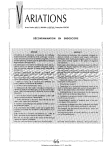
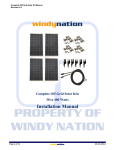




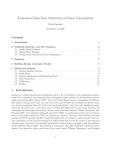

![20 [7] Don Libes, “Using expect to Automate Systems Administration](http://vs1.manualzilla.com/store/data/005773716_1-68a79e060d9ea16881001f4ab808f924-150x150.png)
